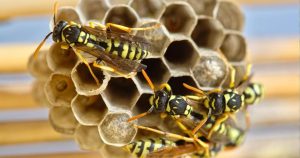As Alberta heats up, so does the buzz, literally. Warmer weather brings out all kinds of flying insects, and while many are harmless pollinators, a few can pack a painful punch. At Poulin’s Pest Control, we know just how important it is to tell the difference between a helpful bee and an aggressive wasp or hornet. Our mission is to help protect your safety. This guide will help you recognize common stinging insects and share effective strategies to avoid getting stung.
Identifying Characteristics: Wasps, Hornets, and Bees
Wasps are generally more aggressive than bees and have a slender body with a narrow “waist.” They appear to have smooth bodies and come in various colours, including yellow and black, and yellow, black, and orange-red/brown. Unlike bees, wasps do not produce honey. Wasps can build nests in the ground, trees, voids, or under eaves and overhangs. They have the ability to sting repeatedly.
Hornets include the black and white bald-faced hornets (actually a type of wasp) and European hornets that stand out with their very large size and yellow-and-red-and-black colouring. European hornets are often confused with Asian giant hornets, but it is far more likely that any very large hornet found is a European hornet. European hornets can be active at night and they are attracted to lights. Both bald-faced hornets and European hornets build their nests in higher locations, but European hornets tend to build their nests in hidden places.
Bees are typically more docile than wasps and hornets and are essential pollinators. They have fuzzy bodies covered in hair. Bees are typically recognized by their yellow and black coloring and a more compact, robust-looking body compared to wasps. Honeybees live in hives and produce honeycomb and honey, while other types of bees, such as bumblebees, nest in the ground or in cavities.
Fresh Perspectives on Identification and Prevention
Beyond physical appearance, understanding the behaviour of these insects can also help you identify them.
Wasps and hornets are often attracted to sugary substances and protein sources, making picnic areas and garbage cans prime locations for their activity. Bees are commonly seen around flowers, collecting nectar and pollen.
To prevent encounters with these stinging insects, it’s essential to take proactive measures. Keep food and drinks covered when eating outdoors, and avoid wearing sweet-smelling perfumes or brightly coloured clothing, as these can attract bees and wasps. Seal garbage cans tightly. Additionally, inspect your property regularly for places that could offer a protected void for wasp nests and watch for any steady stream of wasps coming and going from one spot.
Controlling Wasps, Hornets, and Bees
If you discover a nest on your property, it’s important to handle it with care. Trying to remove a nest on your own can be hazardous and could lead to numerous stings. At Poulin’s Pest Control, we offer professional nest removal services that ensure the safe and effective elimination of wasps, hornets, and bees. Our experienced technicians use specialized equipment and techniques to control wasps, hornets, and bees without putting you or your family at risk.
Knowing how to identify wasps, hornets, and bees is essential for staying safe and preventing stings. By understanding their physical characteristics, behaviour, and nesting habits, you can take proactive measures to minimize your risk of encountering these insects. If you discover a nest on your property or need help with pest control, don’t hesitate to contact Poulin’s Pest Control. Our specialists are ready to offer knowledgeable guidance and reliable pest control solutions. Trust Poulin’s Pest Control to help you experience a pest-free summer season.

